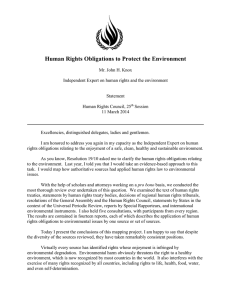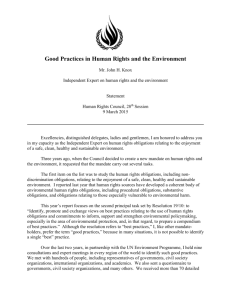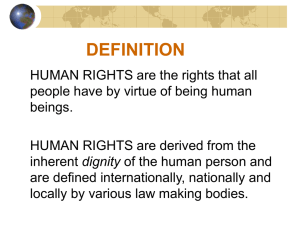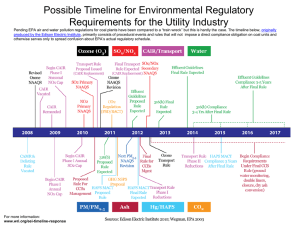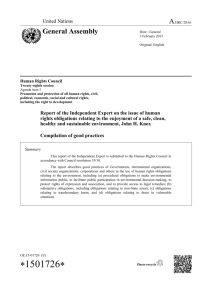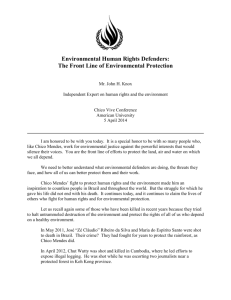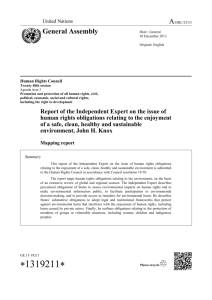Human Rights Obligations to Protect the Environment
advertisement
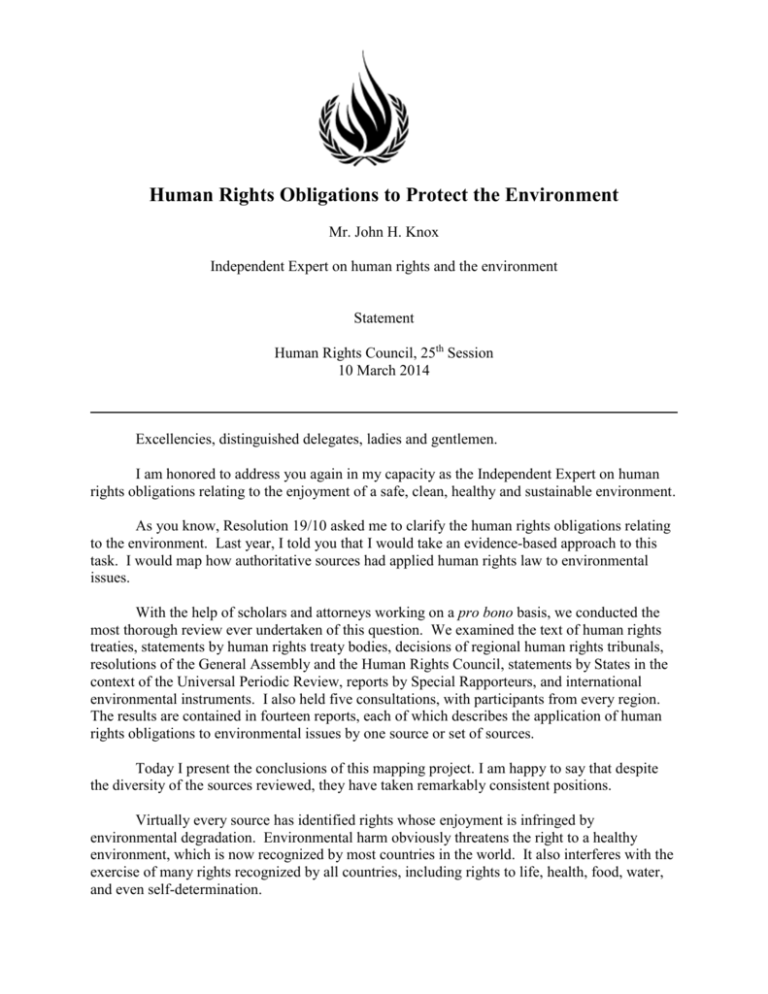
Human Rights Obligations to Protect the Environment Mr. John H. Knox Independent Expert on human rights and the environment Statement Human Rights Council, 25th Session 10 March 2014 Excellencies, distinguished delegates, ladies and gentlemen. I am honored to address you again in my capacity as the Independent Expert on human rights obligations relating to the enjoyment of a safe, clean, healthy and sustainable environment. As you know, Resolution 19/10 asked me to clarify the human rights obligations relating to the environment. Last year, I told you that I would take an evidence-based approach to this task. I would map how authoritative sources had applied human rights law to environmental issues. With the help of scholars and attorneys working on a pro bono basis, we conducted the most thorough review ever undertaken of this question. We examined the text of human rights treaties, statements by human rights treaty bodies, decisions of regional human rights tribunals, resolutions of the General Assembly and the Human Rights Council, statements by States in the context of the Universal Periodic Review, reports by Special Rapporteurs, and international environmental instruments. I also held five consultations, with participants from every region. The results are contained in fourteen reports, each of which describes the application of human rights obligations to environmental issues by one source or set of sources. Today I present the conclusions of this mapping project. I am happy to say that despite the diversity of the sources reviewed, they have taken remarkably consistent positions. Virtually every source has identified rights whose enjoyment is infringed by environmental degradation. Environmental harm obviously threatens the right to a healthy environment, which is now recognized by most countries in the world. It also interferes with the exercise of many rights recognized by all countries, including rights to life, health, food, water, and even self-determination. But human rights bodies have gone beyond describing the effects of environmental harm on the enjoyment of human rights. Together, they have developed a coherent body of environmental human rights obligations, with three principal elements. First, they agree that human rights law imposes procedural obligations on States in relation to environmental protection. These obligations are: (a) to assess environmental impacts and make environmental information public; (b) to facilitate public participation in environmental decision-making, including by protecting the rights of expression and association; and (c) to provide access to effective remedies for environmental harm. These obligations are often considered to correspond to civil and political rights, but in the environmental context they have been derived from the full range of human rights whose enjoyment is threatened by environmental harm, including rights to health, food, and water. Second, States have substantive obligations to protect against environmental harm that interferes with the enjoyment of human rights. Specifically, States have an obligation to adopt a legal framework that protects against such environmental harm. This obligation includes a duty to protect against such harm when it is caused by corporations and other non-State actors, as well as by State agencies. The obligation to protect human rights from environmental harm does not require the cessation of all activities that may cause any environmental degradation. States have discretion to strike a balance between environmental protection and other issues of societal importance, such as economic development and the rights of others. But the balance cannot be unreasonable, or result in unjustified, foreseeable infringements of human rights. In determining whether an environmental law has struck a reasonable balance, relevant factors include whether it meets national and international health standards, and whether it is retrogressive. There is a strong presumption that retrogressive measures are not permissible. Moreover, once a State has adopted environmental standards into its law, it must implement and comply with those standards. Third, States must take into account the situation of groups particularly vulnerable to environmental harm. States must not discriminate against groups on prohibited grounds in the application of their environmental laws and policies. And they must take additional steps to protect certain groups. For example, States should ensure that women are able to participate in environmental decision-making, and States should take care to address environmental harm that may have disproportionate effects on women. Similarly, States should, in the words of the Committee on the Rights of the Child, “take measures to address the dangers and risks that . . . environmental pollution poses to children’s health.” 2 Because of their close relationship with the environment, indigenous peoples are particularly vulnerable to impairment of their rights through environmental harm. As the Special Rapporteur on the rights of indigenous peoples has stated, “the implementation of natural resource extraction and other development projects on or near indigenous territories has become one of the foremost concerns of indigenous peoples worldwide, and possibly also the most pervasive source of the challenges to the full exercise of their rights” (A/HRC/18/35, para. 57). The law on indigenous peoples and environmental harm is now well developed. It requires, among other duties, that States recognize the rights of indigenous peoples with respect to the territory that they have traditionally occupied, and facilitate the participation of indigenous peoples in decisions that concern them. In general, “extractive activities should not take place within the territories of indigenous peoples without their free, prior and informed consent.” And States must ensure that indigenous communities affected by environmental development receive a reasonable benefit from any such development. In sum, on the basis of this mapping project, I believe that it is now beyond argument that human rights law includes obligations relating to the environment. At the same time, I recognize that not all States have formally accepted all of these norms. While some of the statements cited in my report are from legally binding treaties, or from tribunals that have the authority to issue decisions that bind the States subject to their jurisdiction, other statements do not in themselves have binding effect. Nevertheless, they are all from sources with authority to interpret and apply human rights obligations. Taken together, the statements provide strong evidence of converging trends among these human rights bodies towards uniformity and certainty in the application of human rights law to environmental issues. These trends are further by State practice reflected in the Universal Periodic Review process and by international environmental instruments. In this light, I strongly encourage States to accept these statements as evidence of actual or emerging international law. I also recognize that work remains to be done to clarify these obligations further, for example in relation to transboundary environmental harm. The nature and scope of human rights obligations relating to the environment will continue to be considered in many forums, and I trust that States will support their further development and clarification. But the obligations are already clear enough to provide guidance to States and all those interested in promoting human rights and environmental protection. My main recommendation, therefore, is that States and others take these human rights obligations into account in the development and implementation of environmental policies. In my remaining time, I will briefly describe the other work on the mandate over the last year, and my plans for the next year. 3 Resolution 19/10 requests me to contribute a human rights perspective to follow-up processes to the 2012 United Nations Conference on Sustainable Development. Together with other Council mandate-holders, I urged the member States of the Open Working Group on Sustainable Development Goals to take into account the human rights obligations relating to environmental protection as they consider new Goals for the post-2015 period. Resolution 19/10 also requests me to “[i]dentify, promote and exchange views on best practices relating to the use of human rights obligations and commitments to inform, support and strengthen environmental policymaking, especially in the area of environmental protection, and, in that regard, to prepare a compendium of best practices.” I want to thank the UN Environment Programme for its strong support for this aspect of the mandate. Together, we have held a series of consultations, including in Nairobi, Panama, Copenhagen, and Johannesburg, aimed at identifying good practices in the use of human rights obligations in relation to environmental policymaking. We have more consultations scheduled in Bangkok in May, and at Yale University in the United States in September. We have also prepared and will shortly be sending out a questionnaire asking for suggestions about good practices. Our goal is to identify and compile a representative sample of such practices by the spring of 2015. Subject to finding the necessary resources, we would like to make the practices available online in a searchable, easily accessible database. In connection with the identification of good practices, I want to thank the Government of Costa Rica for inviting me to visit that country. My report on the visit describes several innovative ways that Costa Rica uses human rights to support and strengthen its efforts to protect its environment. Let me highlight two, in particular: First, in 1994, Costa Rica amended its constitution to add a right to a healthy and ecologically balanced environment. Its experience since then shows some of the benefits of adopting such a constitutional right. The presence of the right in the highest law of the country symbolizes the importance Costa Rica places on environmental protection, it provides a strong legal basis for its environmental statutes, and it enables direct enforcement by the Constitutional Chamber of the Supreme Court. The second good practice is that the Constitutional Chamber has construed the amparo cause of action very broadly, to allow any person to file a case regarding a constitutional right without a lawyer, with no filing fees, in any language, at any time, on any day of the year and in any form, including handwritten notes. Furthermore, it allows individuals to bring actions on behalf of the public interest, including in the interest of environmental protection. Lowering the barriers to access for those claiming violations of constitutional rights in general, and environmental rights in particular, is truly an exemplary practice, which should be an inspiration to other States. 4 The report also describes some challenges. One problem in particular is faced by many countries – that is, how to set aside protected areas and at the same time respect the rights of those who have been living in those areas for many years, even generations. It is important to ensure that environmental rights never become a reason to violate other rights. Conservation should not impose an undue cost on communities that have deep historical roots in areas of environmental importance. The right to a healthy environment need not conflict with other fundamental rights. On the contrary, as the Costa Rican experience demonstrates, a strong commitment to human rights and to environmental protection can go hand in hand, each strengthening the other. Finally, let me briefly mention two issues I hope to examine in more detail next year. The first is how to better protect environmental defenders. My consultations around the world have repeatedly illustrated that those who defend the environment often do so at great personal risk. States must do more to safeguard their rights of freedom of expression and association against threats, harassment, and violence. Environmental human rights defenders deserve no less protection than other human rights defenders. Over the next year, I plan to examine this problem more closely, starting with the two-day conference hosted this week in Geneva by the Universal Rights Group, and continuing with my next consultation, in Bangkok. The second issue I plan to examine is the relationship of human rights and climate change. It is clear that States have an obligation of international cooperation that is particularly relevant to global harm such as climate change. But the contours of this obligation, as well as many other aspects of the relationship, need further examination, and I hope to hold a consultation to that end. Let me conclude by thanking all of you for the support I have received for this mandate from States and civil society. I continue to be inspired by all of those working to protect and promote human rights and a healthy environment. I look forward to continuing to work with you over the next year. 5
